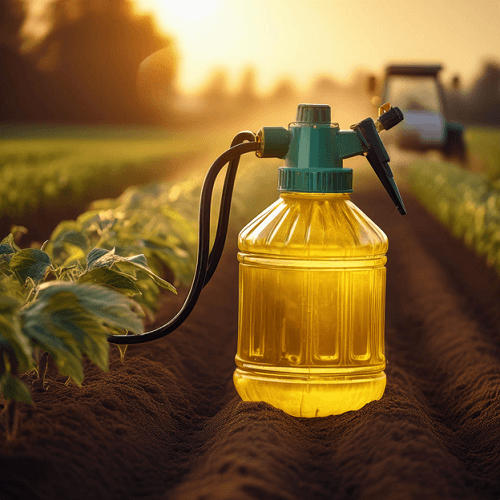Main Points In Hindi (मुख्य बातें – हिंदी में)
-
कृषि कीटाणुनाशकों का महत्व: कृषि कीटाणुनाशक स्वस्थ फसलों और पशुधन को बनाए रखने के लिए जरूरी हैं, क्योंकि ये बीमारियों और प्रदूषण से बचाते हैं, जिससे आर्थिक नुकसान और कम पैदावार की संभावना कम हो जाती है।
-
प्रपत्र द्वारा बाजार विभाजन: कृषि कीटाणुनाशक मुख्यतः तरल, पाउडर, जैल, और कणिकाओं के रूप में आते हैं। तरल कीटाणुनाशक बड़े पैमाने पर उपयोग के लिए लोकप्रिय हैं, जबकि पाउडर और जैल अधिक लक्षित अनुप्रयोगों के लिए उपयुक्त हैं।
-
अनुप्रयोग और प्रभाव: कृषि कीटाणुनाशक का उपयोग फसलों की सुरक्षा, जल शुद्धता, और हवाई कीटाणुशोधन में किया जाता है, जो एक स्वस्थ और अधिक उत्पादक खेती के वातावरण को सुनिश्चित करते हैं।
-
वैश्विक बाजार विकास कारक: खाद्य सुरक्षा के प्रति बढ़ती जागरूकता, बीमारियों का बढ़ता प्रकोप, और वैश्विक जनसंख्या वृद्धि जैसे कारक कृषि कीटाणुनाशकों के बाजार को बढ़ावा दे रहे हैं।
- भविष्य का आउटलुक: कृषि कीटाणुनाशक बाजार में आने वाले वर्षों में निरंतर वृद्धि की उम्मीद है, खासकर टिकाऊ और पर्यावरण-अनुकूल उत्पादों की मांग बढ़ने के साथ।
Main Points In English(मुख्य बातें – अंग्रेज़ी में)
Here are the main points from the provided text about agricultural disinfectants:
-
Importance of Agricultural Disinfectants: Agricultural disinfectants play a crucial role in protecting crops and livestock from diseases and contaminants, ensuring higher productivity and preventing economic losses through the elimination of harmful bacteria, viruses, fungi, and parasites.
-
Forms and Applications: These disinfectants are available in various forms, including liquids, powders, gels, and granules, each suited to different agricultural needs. Liquid disinfectants are favored for large-scale spraying, while powders and granules are more suitable for targeted applications and have a longer shelf life.
-
Market Trends: The agricultural disinfectant market is experiencing growth driven by increasing awareness of food safety and disease prevalence among crops and livestock. Additionally, there is a shift towards environmentally friendly and biodegradable products due to mounting environmental concerns.
-
Regional Demand Variances: Demand for agricultural disinfectants varies by region, influenced by local farming practices, regulatory requirements, and disease prevalence. North America and Europe hold significant market portions, whereas the Asia-Pacific region is projected to grow the fastest due to rising agricultural production demands.
- Future Outlook: The future of the agricultural disinfectant market appears promising, with expected continuous growth driven by an increasing global population and the need for efficient, sustainable agricultural practices to ensure healthy crops and livestock.


Complete News In Hindi(पूरी खबर – हिंदी में)
कृषि वैश्विक खाद्य उत्पादन की रीढ़ है, और स्वस्थ फसलों और पशुधन को बनाए रखने के लिए कृषि वातावरण की सुरक्षा और स्वच्छता सुनिश्चित करना महत्वपूर्ण है। कृषि कीटाणुनाशक भूमि और जानवरों दोनों को बीमारियों और प्रदूषकों से बचाने में एक मौलिक उपकरण के रूप में उभरा है जिससे आर्थिक नुकसान और कम पैदावार हो सकती है। हानिकारक बैक्टीरिया, वायरस, कवक और परजीवियों को मारकर, ये कीटाणुनाशक खेती के लिए एक सुरक्षित, अधिक उत्पादक वातावरण सुनिश्चित करते हैं। यह ब्लॉग कृषि कीटाणुनाशकों के लिए बाजार का पता लगाएगा, वैश्विक स्तर पर इसके आकार, हिस्सेदारी, विकास के रुझान और भविष्य के दृष्टिकोण का विश्लेषण करेगा।
कृषि कीटाणुनाशकों का अवलोकन
कृषि कीटाणुनाशक विभिन्न रूपों में उपलब्ध हैं, जिनमें तरल पदार्थ, पाउडर, जैल और कणिकाएँ शामिल हैं। इनमें से प्रत्येक फॉर्म के अपने फायदे हैं, जो आवेदन के प्रकार और विशिष्ट कृषि आवश्यकताओं पर निर्भर करते हैं। तरल कीटाणुनाशक बड़े पैमाने पर छिड़काव के लिए आदर्श होते हैं, जबकि पाउडर और दाने विस्तारित शेल्फ जीवन प्रदान करते हैं और अधिक लक्षित कीटाणुशोधन प्रयासों के लिए उपयुक्त होते हैं। जैल, हालांकि आमतौर पर कम उपयोग किया जाता है, उन विशिष्ट क्षेत्रों में लागू किया जा सकता है जहां लगातार एक्सपोज़र की आवश्यकता होती है। इन विभिन्न रूपों द्वारा प्रदान किया गया लचीलापन कृषि कीटाणुनाशकों को बहुमुखी बनाता है और विभिन्न कृषि पद्धतियों में स्वच्छता के उच्च मानकों को बनाए रखने के लिए आवश्यक है।
प्रपत्र द्वारा बाज़ार विभाजन
कृषि कीटाणुनाशक चार मुख्य रूपों में आते हैं: तरल पदार्थ, पाउडर, जैल और कणिकाएँ। बड़े पैमाने पर कृषि सेटिंग्स में उपयोग में आसानी और प्रभावशीलता के कारण तरल कीटाणुनाशक बाजार पर हावी हैं। वे विशेष रूप से उपकरण और सतहों को जल्दी और कुशलता से साफ करने के लिए पसंदीदा हैं, कम समय में व्यापक क्षेत्रों को कवर करते हैं। दूसरी ओर, पाउडर कीटाणुनाशकों का उपयोग अक्सर तब किया जाता है जब लंबी शेल्फ लाइफ की आवश्यकता होती है, क्योंकि उन्हें अपनी क्षमता खोए बिना लंबे समय तक संग्रहीत किया जा सकता है। इन्हें आम तौर पर सतहों पर लगाया जाता है या सफाई उद्देश्यों के लिए पानी में मिलाया जाता है। विशिष्ट क्षेत्रों में अधिक लक्षित कीटाणुशोधन के लिए जैल और ग्रैन्यूल का उपयोग तेजी से किया जा रहा है, जैसे पशुधन फार्मों पर भोजन क्षेत्र या उच्च यातायात वाले क्षेत्र। ये फॉर्म उन अनुप्रयोगों के लिए भी उपयोगी हैं जहां पारंपरिक स्प्रे व्यावहारिक नहीं हो सकते हैं, अपशिष्ट को कम करते हैं और कीटाणुनाशक के अधिक केंद्रित अनुप्रयोग को सुनिश्चित करते हैं।
कृषि कीटाणुनाशकों के प्रमुख अनुप्रयोग
कृषि कीटाणुनाशकों का कृषि कार्यों में व्यापक अनुप्रयोग होता है। फसलों को मिट्टी-जनित रोगज़नक़ों से बचाने के लिए भूमि कीटाणुशोधन महत्वपूर्ण है, जो अनियंत्रित रहने पर पैदावार को गंभीर रूप से प्रभावित कर सकता है। मिट्टी में कीटाणुनाशक लगाने से, किसान उकठा और जड़ सड़न जैसी बीमारियों के खतरे को कम कर सकते हैं, जिससे एक स्वस्थ बढ़ते वातावरण को बढ़ावा मिल सकता है। पानी को साफ करना भी उतना ही महत्वपूर्ण है, खासकर पशुधन फार्मों के लिए, जहां जानवरों के स्वास्थ्य को बनाए रखने के लिए साफ पानी आवश्यक है। दूषित जल स्रोतों से बीमारियाँ फैल सकती हैं जो झुंडों को नष्ट कर सकती हैं या उपज की गुणवत्ता को कम कर सकती हैं। जल प्रणालियों में उपयोग किए जाने वाले कीटाणुनाशक यह सुनिश्चित करते हैं कि सिंचाई और पीने का पानी हानिकारक बैक्टीरिया और वायरस से मुक्त हो। हवाई कीटाणुशोधन एक और महत्वपूर्ण अनुप्रयोग है, विशेष रूप से ग्रीनहाउस या खलिहान जैसे बड़े इनडोर स्थानों में। हवाई स्प्रे का उपयोग वायुजनित रोगजनकों को नियंत्रित करने के लिए किया जाता है जो सीमित स्थानों में पौधों या जानवरों के बीच तेजी से फैल सकते हैं, जिससे एक स्वस्थ, अधिक उत्पादक वातावरण सुनिश्चित होता है।
वैश्विक बाज़ार विकास चालक
कृषि कीटाणुनाशकों का वैश्विक बाज़ार कई प्रमुख कारकों से संचालित हो रहा है। सबसे पहले, उपभोक्ताओं और नियामक निकायों दोनों के बीच खाद्य सुरक्षा के बारे में जागरूकता बढ़ रही है। परिणामस्वरूप, किसानों पर अपनी उपज की गुणवत्ता और सुरक्षा सुनिश्चित करने के लिए स्वच्छता की स्थिति बनाए रखने का दबाव बढ़ रहा है। दूसरा, फसलों और पशुधन दोनों को प्रभावित करने वाली बीमारियों का प्रचलन बढ़ रहा है, जिससे कीटाणुनाशक रोग निवारण रणनीतियों का एक महत्वपूर्ण हिस्सा बन गया है। अंततः, जैसे-जैसे वैश्विक जनसंख्या बढ़ती जा रही है, भोजन की बढ़ती मांग को पूरा करने के लिए उच्च कृषि उत्पादकता की आवश्यकता है। इससे उत्पादन को अधिकतम करने और बीमारी के कारण होने वाले नुकसान के जोखिम को कम करने के लिए कीटाणुनाशकों के उपयोग सहित उन्नत कृषि पद्धतियों को अपनाया गया है।
कृषि कीटाणुनाशक बाजार को आकार देने वाले रुझान
कृषि कीटाणुनाशक बाजार को आकार देने वाले सबसे महत्वपूर्ण रुझानों में से एक पर्यावरण-अनुकूल और बायोडिग्रेडेबल उत्पादों की ओर बढ़ना है। जैसे-जैसे पर्यावरणीय चिंताएँ अधिक प्रमुख होती जा रही हैं, उपभोक्ता और नियामक दोनों टिकाऊ कृषि पद्धतियों पर जोर दे रहे हैं जो पर्यावरण पर रसायनों के प्रभाव को कम करती हैं। इससे कीटाणुनाशकों का विकास हुआ है जो न केवल प्रभावी हैं बल्कि पर्यावरण में अधिक आसानी से विघटित हो जाते हैं, जिससे उनका दीर्घकालिक पारिस्थितिक प्रभाव कम हो जाता है। इसके अतिरिक्त, जैविक खेती में रुचि बढ़ रही है, जहां सिंथेटिक रसायनों की तुलना में प्राकृतिक कीटाणुनाशकों को प्राथमिकता दी जाती है। स्थिरता की दिशा में इस बदलाव से कीटाणुनाशक बाजार में नवाचार जारी रहने की संभावना है।
क्षेत्रीय बाज़ार विश्लेषण
कृषि कीटाणुनाशकों की मांग अलग-अलग क्षेत्रों में अलग-अलग होती है, जो खेती के तरीकों, नियामक आवश्यकताओं और बीमारियों की व्यापकता जैसे कारकों से प्रभावित होती है। उन्नत कृषि पद्धतियों और खाद्य सुरक्षा और कृषि स्वच्छता के संबंध में सख्त नियमों द्वारा संचालित, उत्तरी अमेरिका बाजार का एक महत्वपूर्ण हिस्सा रखता है। यूरोप में, पशु कल्याण और पशुधन रोगों की रोकथाम पर ध्यान देने के साथ, बाजार भी मजबूत है। एशिया-प्रशांत में सबसे तेज़ विकास होने की उम्मीद है, क्योंकि चीन और भारत जैसे देश अपनी बड़ी आबादी की मांगों को पूरा करने के लिए अपने कृषि उत्पादन में वृद्धि कर रहे हैं। इन क्षेत्रों में, उच्च उत्पादकता और बीमारी की रोकथाम की आवश्यकता के कारण कृषि कीटाणुनाशकों को तेजी से अपनाया जा रहा है।
प्रतिस्पर्धी परिदृश्य
कृषि कीटाणुनाशक बाजार अत्यधिक प्रतिस्पर्धी है, जिसमें कई प्रमुख खिलाड़ी बाजार हिस्सेदारी के लिए प्रतिस्पर्धा कर रहे हैं। ये कंपनियां अधिक प्रभावी और पर्यावरण के अनुकूल उत्पाद प्रदान करने के लिए लगातार नवाचार कर रही हैं। प्रमुख खिलाड़ी कीटाणुनाशक बनाने के लिए अनुसंधान और विकास में भी निवेश कर रहे हैं जो विभिन्न कृषि वातावरणों की विशिष्ट आवश्यकताओं को पूरा कर सकते हैं, चाहे वह फसल सुरक्षा हो या पशुधन स्वास्थ्य। इसके अतिरिक्त, कंपनियां अपनी भौगोलिक उपस्थिति का विस्तार करने पर ध्यान केंद्रित कर रही हैं, खासकर उभरते बाजारों में जहां कृषि कीटाणुनाशकों की मांग तेजी से बढ़ रही है।
भविष्य का आउटलुक और पूर्वानुमान
कृषि कीटाणुनाशक बाजार का भविष्य आशाजनक लग रहा है, अगले कई वर्षों में इसमें लगातार वृद्धि की उम्मीद है। जैसे-जैसे वैश्विक आबादी बढ़ती जा रही है, वैसे-वैसे भोजन की मांग भी बढ़ेगी, जिससे किसानों पर अधिक कुशल और टिकाऊ कृषि पद्धतियों को अपनाने का दबाव बढ़ेगा। कृषि कीटाणुनाशक बीमारियों को नियंत्रित करने और फसलों और पशुधन दोनों के लिए एक स्वस्थ वातावरण सुनिश्चित करके किसानों को इस चुनौती से निपटने में मदद करने में महत्वपूर्ण भूमिका निभाएंगे। चल रहे नवाचार और पर्यावरण-अनुकूल उत्पादों की ओर बदलाव के साथ, बाजार निरंतर विस्तार के लिए तैयार है।
ये जानकारियां एक रिपोर्ट पर आधारित हैंकृषि कीटाणुनाशक बाजार ट्रांसपेरेंसी मार्केट रिसर्च द्वारा
पोस्ट दृश्य: 89
Complete News In English(पूरी खबर – अंग्रेज़ी में)
Agriculture is the backbone of global food production, and it is crucial to ensure a safe and clean environment for maintaining healthy crops and livestock. Agricultural disinfectants have emerged as essential tools for protecting land and animals from diseases and pollutants, which can lead to economic losses and reduced yields. By killing harmful bacteria, viruses, fungi, and parasites, these disinfectants help create a safer and more productive farming environment. This blog will explore the agricultural disinfectant market, analyzing its global size, share, growth trends, and future prospects.
Overview of Agricultural Disinfectants
Agricultural disinfectants come in various forms, including liquids, powders, gels, and granules. Each form has its own advantages, depending on the type of application and specific agricultural needs. Liquid disinfectants are ideal for large-scale spraying, while powders and granules offer extended shelf life and are suitable for targeted disinfection efforts. Gels, though less commonly used, can be applied in specific areas where continuous exposure is needed. This variety provides the flexibility required to maintain high hygiene standards across different agricultural practices.
Market Segmentation by Form
Agricultural disinfectants are primarily available in four forms: liquids, powders, gels, and granules. Liquid disinfectants dominate the market due to their ease of use and effectiveness in extensive agricultural settings. They are preferred for quickly and efficiently cleaning equipment and surfaces, covering large areas in a short time. In contrast, powder disinfectants are often utilized when a long shelf life is necessary, as they can be stored for extended periods without losing effectiveness. They are typically applied to surfaces or mixed with water for cleaning purposes. Gels and granules are increasingly used for targeted disinfection in specific areas, such as feeding zones on livestock farms or high-traffic locations, ensuring a more concentrated application and reducing waste.
Main Applications of Agricultural Disinfectants
Agricultural disinfectants have various applications in farming operations. Soil disinfection is vital for protecting crops from soil-borne pathogens, which can severely impact yields if left uncontrolled. By applying disinfectants to the soil, farmers can reduce the risk of diseases like wilt and root rot, fostering a healthier growing environment. Cleansing water is equally essential, especially on livestock farms, where clean water is critical for maintaining animal health. Contaminated water sources can spread diseases that can devastate livestock or reduce crop quality. Disinfectants used in water systems ensure that irrigation and drinking water are free from harmful bacteria and viruses. Airborne disinfection is another important application, particularly in large indoor spaces like greenhouses or barns. Aerial sprays help control airborne pathogens that can quickly spread between plants or animals in confined areas, ensuring a healthier, more productive environment.
Drivers of Global Market Growth
The global agricultural disinfectant market is driven by several key factors. Firstly, there is a growing awareness of food safety among consumers and regulatory bodies, increasing pressure on farmers to maintain hygiene standards for the quality and safety of their produce. Secondly, the rise in diseases affecting both crops and livestock makes disinfectants a crucial part of disease prevention strategies. Finally, as the global population continues to grow, there is an increasing need for higher agricultural productivity to meet food demands. This has led to the adoption of advanced agricultural practices, including the use of disinfectants to maximize production and minimize disease-related losses.
Trends Shaping the Agricultural Disinfectant Market
One of the most significant trends influencing the agricultural disinfectant market is the shift towards eco-friendly and biodegradable products. As environmental concerns gain prominence, both consumers and regulators are emphasizing sustainable agricultural practices that reduce the chemical impact on the environment. This has resulted in the development of disinfectants that are not only effective but also decompose more easily in the environment, reducing their long-term ecological footprint. Additionally, there is a growing interest in organic farming, where natural disinfectants are preferred over synthetic chemicals. This shift towards sustainability is likely to continue fostering innovation in the disinfectant market.
Regional Market Analysis
The demand for agricultural disinfectants varies across regions, influenced by factors such as farming methods, regulatory requirements, and the prevalence of diseases. North America holds a significant portion of the market, driven by advanced agricultural practices and strict regulations regarding food safety and sanitation. Europe also has a robust market, focusing on animal welfare and disease prevention in livestock. The Asia-Pacific region is expected to see the fastest growth, with countries like China and India working to increase agricultural production to meet the demands of their large populations. In these regions, the need for high productivity and disease prevention is leading to a rapid adoption of agricultural disinfectants.
Competitive Landscape
The agricultural disinfectant market is highly competitive, with several key players vying for market share. These companies continuously innovate to provide more effective and eco-friendly products. Major players are also investing in research and development to create disinfectants tailored to the specific needs of various agricultural environments, whether for crop protection or livestock health. Additionally, companies focus on expanding their geographic presence, particularly in emerging markets where the demand for agricultural disinfectants is rapidly increasing.
Future Outlook and Forecast
The future of the agricultural disinfectant market looks promising, with steady growth anticipated over the coming years. As the global population continues to rise, the demand for food will also increase, putting pressure on farmers to adopt more efficient and sustainable agricultural practices. Agricultural disinfectants will play a critical role in helping farmers address this challenge by controlling diseases and ensuring a healthy environment for crops and livestock. With ongoing innovation and a shift towards eco-friendly products, the market is set for further expansion.
This information is based on a report on the agricultural disinfectant market by Transparency Market Research.
Post Views: 89








